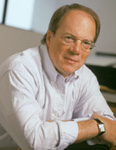 Wisconsin Lawyer
Wisconsin Lawyer
Vol. 83, No. 11, November 2010
by George C. Brown ,
State Bar executive director
 There’s an old story in academia, possibly apocryphal, that goes something like the following.
There’s an old story in academia, possibly apocryphal, that goes something like the following.
In the mid-1880s, Leland Stanford, the California railroad magnate, and his wife, Jane, toured Harvard University. As they admired the stately halls of learning surrounding them in Harvard Yard, Stanford turned to the university’s president, Charles William Eliot, and asked him the present-day cost of the Harvard University buildings. President Eliot proudly announced, “approximately $100 million.” Mrs. Stanford then turned to her husband, smiled, and said, “Oh, Leland, we can do it!”
Marquette University Law School Dean Joseph Kearney might also have thought “we can do it” when he learned that Ray Eckstein, a 1949 law school graduate, and his wife, Kay, had pledged $51 million toward the $85 million budget for Marquette’s new law school building. This was the largest gift ever given to Marquette University and one of the largest ever given to a law school in the country. Hundreds more individuals and groups have donated to the building, most notably Marquette Law School alums Joe Zilber and Wylie Aitken, for whom the four-story commons (the Joseph and Vera Zilber Forum) and the Wylie and Bette Aitken Reading Room are named.
The new law school building – known as Ray and Kay Eckstein Hall – was dedicated on Sept. 8 in a ceremony that featured Wisconsin Supreme Court Chief Justice Shirley Abrahamson, U.S. Supreme Court Justice Antonin Scalia, and Archbishop Timothy Dolan of New York, who led the Archdiocese of Milwaukee when ground was broken.
Eckstein Hall dominates the southeast corner of the university campus. Its reading room, a combination of modern towering steel and glass offset by the warmth of traditional wood paneling and a stone fireplace, provides welcome quiet for law students. Outside the reading room is the school’s library without borders. Instead of the numerous volumes being tucked away in a corner, the books are in the open, readily available on each of the four stories of Eckstein Hall, and surrounded by classrooms and study spaces that encourage active interchange among students and between students and faculty. On the other side of the building are lecture halls, the 200-seat moot court room, and faculty offices. These amenities overlook a central atrium that rises from the commons on the ground floor to the rooftop. Open, warm and bright, the building’s physical layout encourages openness and collaboration among the students, skills that many believe will be among the most important required of tomorrow’s successful lawyers.
In the words of Dean Kearney, “We seek for Marquette Law School to be the place where students, lawyers, business leaders, judges, academics, policymakers – all engaged citizens, really – come to explore and discuss public policy problems and find, perhaps, some common ground and even some common solutions.”
For more about Eckstein Hall, see “Marquette’s New Law School Promotes Both Traditional and Modern Law Study” in the Sept. 1, 2010, issue of WisBar InsideTrack™, www.wisbar.org/insidetrack.
Wisconsin Lawyer
